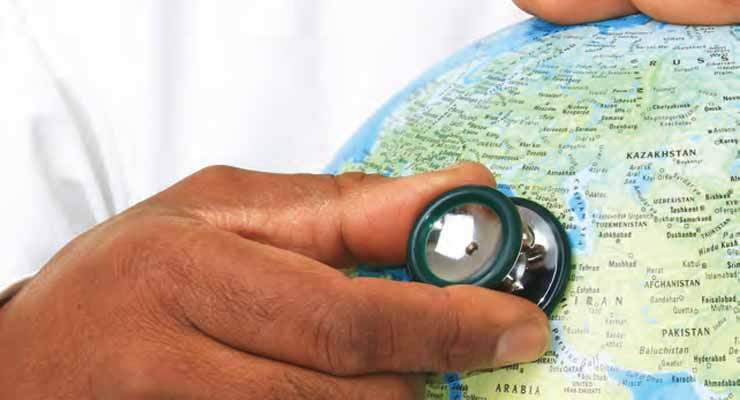THE QUALITY OF THEIR OFFERINGS AND SERVICES, EAGER TO BE RECOGNISED AS THE BEST IN THE REGION.
Despite the centuries-old credentials of many acclaimed Middle Eastern medical tourism hubs, the region has still not realised its full potential when it comes to this niche sector.
The main reason for this is the ongoing political and social challenges the region faces, which are holding back even the most stellar medical tourism destinations such as Jordan and Lebanon.
However, the industry continues to move forward and this year saw a renewed push for re-energising the sector and re-establishing it on the global medical tourism market.
Jordan, for example, was recently in the medical industry spotlight due to an in-depth training programme hosted by the country's Medical Tourism Association and Certified Medical Tourism Professional (CMTP).
The event, which took place in Amman in late May, was designed to teach participants – among which also travel agents interested in working in the sector – how to successfully sell this type of products and services.
More recently, showing its belief in the unique strength of the country's medical offerings was Mövenpick Hotels & Resorts, which appointed a new regional director to promote the group's portfolio in the country, relying on its allure to medical travellers worldwide.
The Kingdom's medical establishments are also working hard to grow the number of global visitors.
"International patients are very important to Gardens Hospital, and the main goal of our marketing department is to reach out to international patients and provide them with our unique medical services," said Dr Marwan Al-Abdallat, director, marketing, sales and public relations, Gardens Hospital.
Gardens Hospital offers a wide range of treatments across 30 departments, spanning both general medicine and specialised care.
It is especially known for its physiotherapy department, the largest and best in the region according to Al-Abdallat.
As for in-hospital accommodation, patients are offered 165 beds. Apart from this, as Al-Abdallat highlighted, in order to cater to its international clientele, the medical hub also provides medical tourism services like pick-up to and from the airport, accommodation and lodging as well as medical trips across Jordan.
Another destination which is especially active in boosting its worldwide reputation as a medical tourism hub is Dubai, which attracted 118,727 domestic and inbound medical tourists in the first quarter of the year, according to Dubai Statistics Center and Dubai Medical Tourism Club.
Layla Al Marzouqi, head, clinical governance office, health regulation department, Dubai Health Authority (DHA), elaborated, “In 2012, the total revenue from medical tourism reached AED652.7 million (USD177.7 million) and now in quarter one [of this year] the revenue is AED778.5 million (USD212 million).
We expect this number to multiply by the end of the year.
Our target for 2016 was AED1.2 billion (USD322.6 million) but we will surpass this soon and we aim to exceed our 2020 target which is AED2.6 billion (USD710 million) by an additional 20 percent.”
As she further revealed, 46 percent of Dubai’s medical tourists come from Asia, about a quarter are from the GCC and Arab states, 13 percent represent African countries and the rest originate from other markets, including the UK and the CIS. As for the most popular services, orthopaedics surgeries, dental treatments and cosmetics dermatology continue to lead.
Revealing the emirate’s ambitions, Al Marzouqi confirmed that Dubai is seeking to position itself within the top 15 destinations globally for medical tourism, and as the first in the region.
“According to the Medical Tourism Destination Index (MTDI) which was published by the Medical Tourism Association in 2014, Dubai ranks 17th in the world out of 25 countries that the index comprises, and accordingly the seventh in Asia and second in the MENA region,” she elucidated.
To further enhance and expand the city’s facilities and medical services on offer, its buzzing medical hub, Dubai Healthcare City, is currently undergoing an expansion with phase two also incorporating wellness services.
Wellness was also pinpointed as one of the emirate’s eight health-related tourism segments at the recently held World Health Tourism Congress. Supported by DHA and Dubai Department of Tourism & Commerce Marketing and co-hosted by Dubai Healthcare City, the initiative also highlighted the potential of medical, dental, spa and accessible tourism, among other niches.
However, Dubai is not the only ambitious destination in the region aspiring to be named top in this segment.
Towards the east is another contender with immense potential, especially when it comes to serving the MENA market: Turkey.
“Medical tourism is the key tourism sector in [the country] as Turkey became a hub in the Mediterranean area and the Middle East – like a rising star, recently having welcomed a huge number of visitors, especially from the GCC, Iraq, Syria, Libya and Morocco,” enthused Didem Özyiğit, general manager, Harmonia Surgical Tourism, Istanbul, one of the leading medical tourism facilitators in the country.
These visitors, in addition to Europeans and Africans, are, as she revealed, allured by Turkey’s thermal waters, advanced medical facilities and affordable prices. As for the services, the most popular ones include Follicular unit extraction, hair transplantation, laser eye surgeries, cosmetic dentistry and aesthetic surgeries.
“For [travellers from] the Middle East, Turkey has been a great attraction for reconstructive surgeries and heart bypasses, kidney and heart transplantations, and similar [procedures],” she elaborated.
In addition to the quality of medical offerings and based on reviews submitted by patients, these travellers value the fact that communication and correspondence with Turkey’s healthcare service providers is friendly and prompt, and that the country offers American and European-standard medical care as well as five-star hotels with concierge services.
“Being in this business for years, I am proud to say that we improved ourselves in serving international patients from all around the world, with Turkish Airlines flying to nearly all [parts of] the world directly, which is also a very important point for the increased demand for our country, [as it is] one of the easiest locations to come for a surgery,” Özyiğit concluded.
So, it seems that the region has at least three serious contenders when it comes to providing top-quality medical treatments and services to visitors from abroad, each boasting its own strengths and opportunities for further growth. And perhabs, the next years will see the full recovery of other acclaimed medical tourism destinations like Lebanon and Egypt, to further step up the game and unleash the region’s full potential.









